Featured Comment:
“Great recipe! Worked wonders and enjoyed by the whole family.”
– Karl-Henrik
What is Toriten (Japanese Chicken Tempura)?
You might think chicken tempura is simply a deep-fried chicken with tempura batter, but technically, this is not the case. The batter is thicker to coat the smooth surface of the chicken, and the chicken meat itself is marinated. I would say it’s more like a cross between Tempura and Karaage.
Toriten is a regional specialty of Oita Prefecture, located on the southwestern island of Kyushu. It originated in the early Showa period (around the 1930s) at a Chinese restaurant called “Toyoken” in Beppu City.
Interestingly, Oita Prefecture is known throughout Japan for its high chicken consumption, making it the perfect birthplace for this beloved chicken dish. Locals enjoy toriten as a soul food, served with a ponzu-like sauce and often garnished with Kabosu citrus, another Oita specialty.
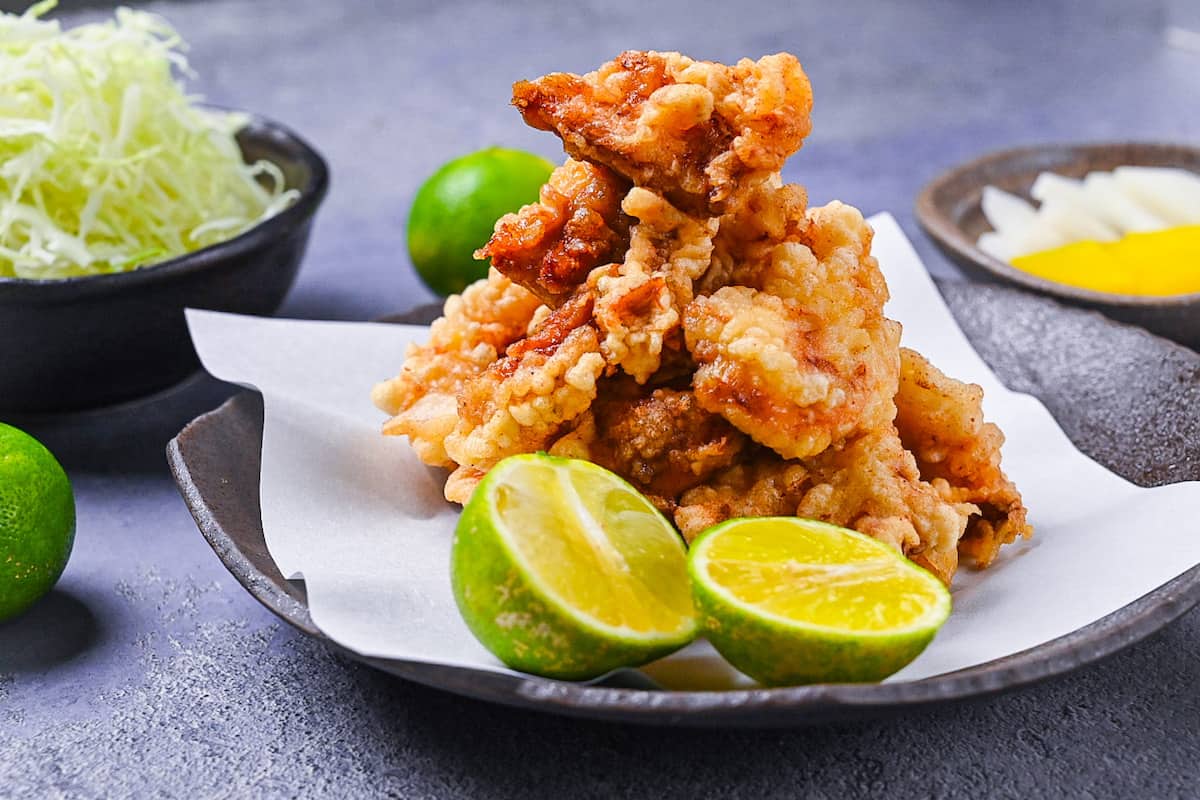
Visual Walkthrough & Tips
Here are my step-by-step instructions for how to make Chicken Tempura at home. For ingredient quantities and simplified instructions, scroll down for the Printable Recipe Card below.
If you prefer to watch the process in action, check out my YouTube video of this Toriten recipe for a complete visual walkthrough!
First, cut the chicken breast into bite-sized pieces, but not just any way. For the best Toriten, cut the chicken against the grain (across the muscle fibers) in a diagonal cutting motion. This technique, called “sogigiri (そぎ切り)” in Japanese cuisine, makes the meat more tender and helps the heat to penetrate it better.
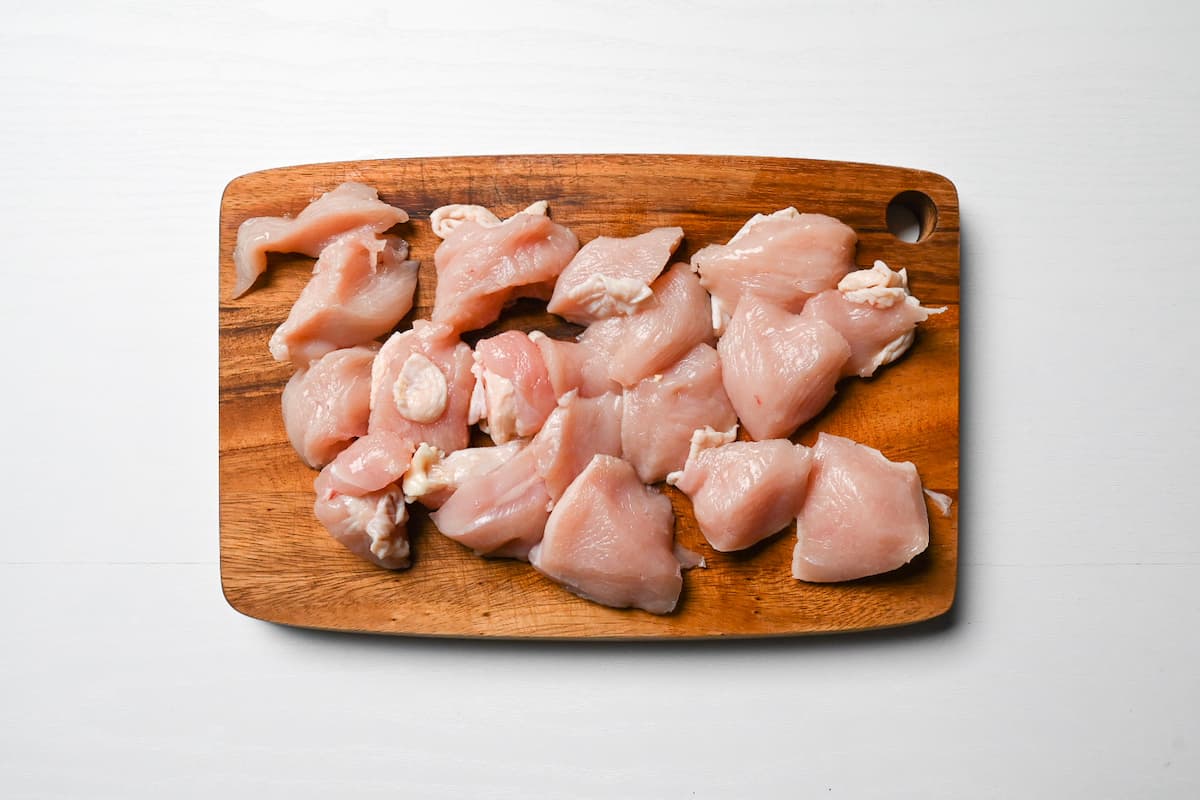
Aim for slices about 5mm-1cm thick. It sounds straightforward, but too thick, and the center won’t cook properly before the batter browns; too thin, and the chicken might become dry. I also recommend making the pieces just slightly larger than bitesize, as they’ll shrink a bit during cooking.
Try to cut all the chicken pieces into similar sizes so they cook evenly. If the pieces are uneven, some will be overcooked while others might not cook all the way through.
In a bowl, mix together soy sauce, grated garlic, grated ginger, sake, and sesame oil. Add the chicken pieces and make sure each piece is coated evenly.
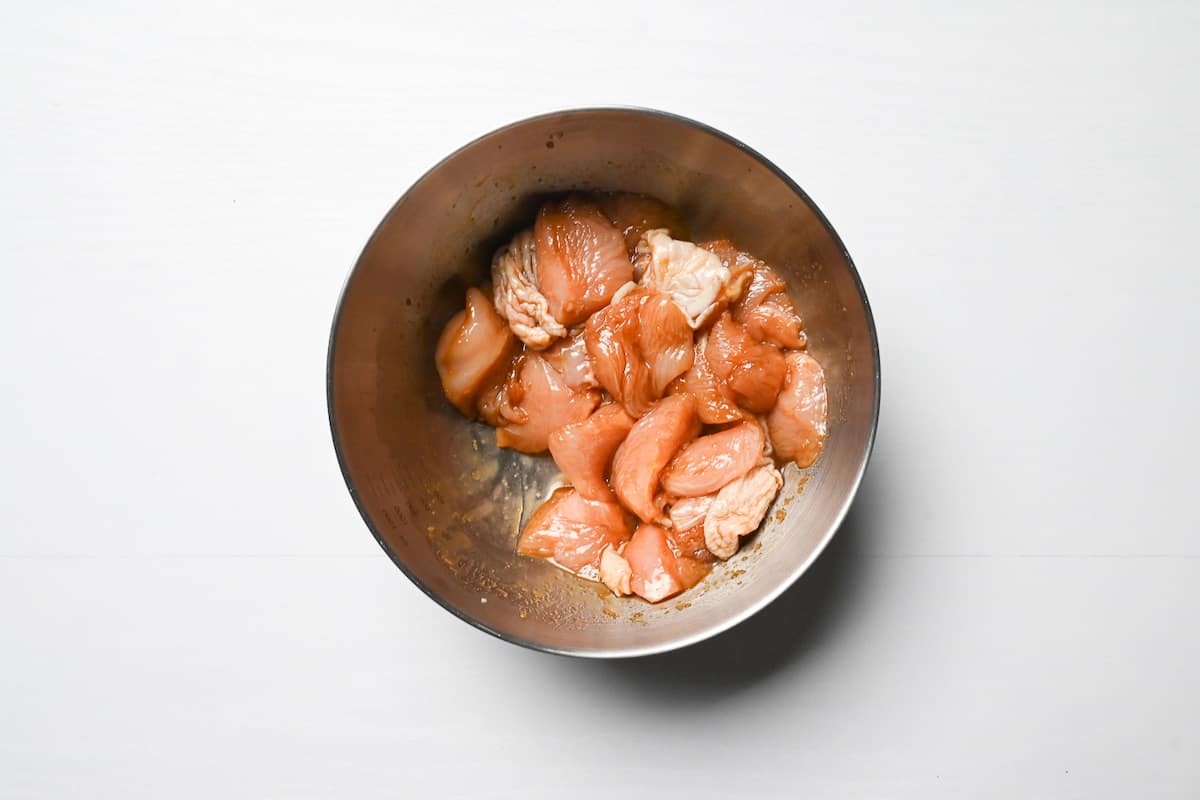
The marinade does more than just add flavor. The salt in soy sauce creates a brining effect, helping the chicken retain moisture during frying. Ginger contains natural enzymes (proteases) that tenderize the meat by breaking down proteins.
However, these enzymes can over-tenderize if left too long, turning your chicken mushy – which is why 30 minutes is the sweet spot!
One of the most important steps in making the right Toriten is getting the batter right. Use chilled water straight from the refrigerator—no excuses, this is key for getting that crispy texture we all love!
Measure out the water at the beginning and keep it in the fridge while the chicken marinates. You can even add ice cubes to keep the water cold.
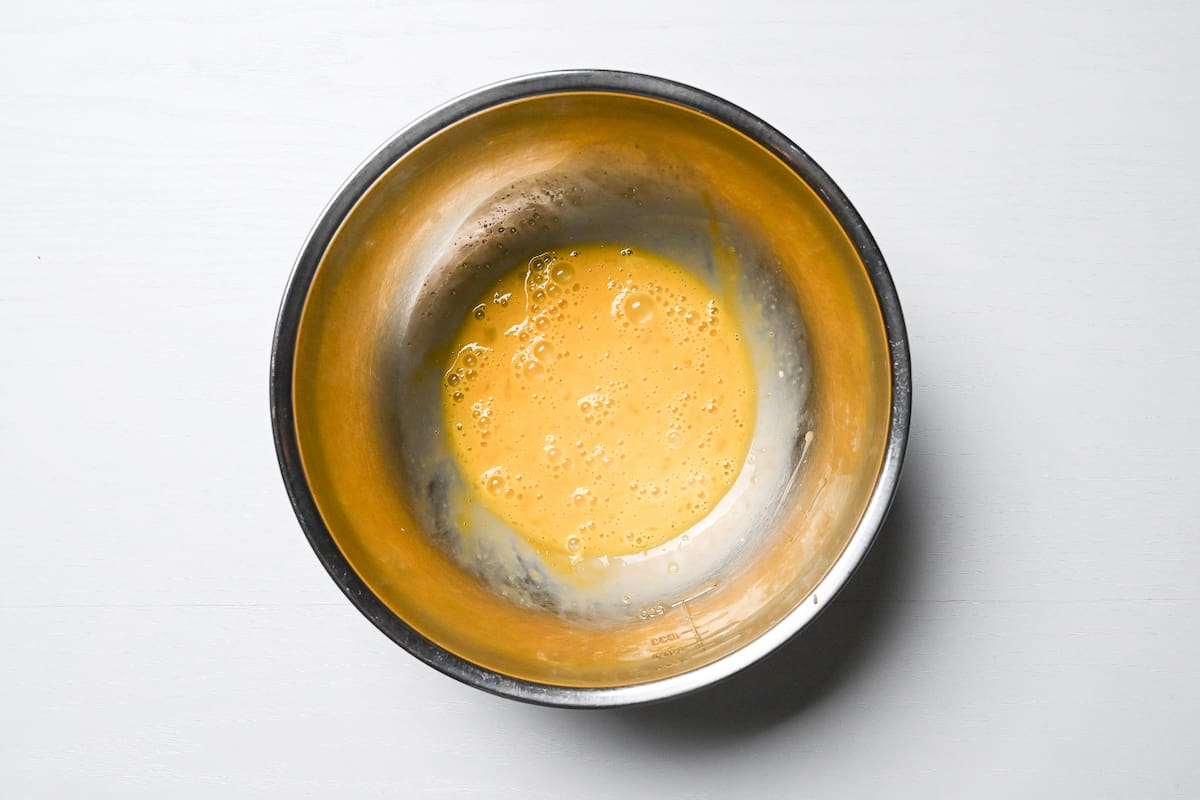
Crack your egg into a bowl and add the chilled water. Then, whisk them together slowly and gently. If you whisk too vigorously, you’ll incorporate too much air, and this will make your batter heavy rather than light and crisp.
Cold water slows down gluten formation. Gluten is formed when wheat flour proteins combine and form elastic strands, which is great for bread but terrible for tempura.
Keeping everything cold slows down this chemical reaction, which is what gives Toriten its light, crispy texture.
Sift in flour and potato starch in the same bowl and whisk them together. The potato starch is crucial – it’s what gives Toriten its distinctive crispy-yet-light texture, different from regular tempura or karaage.
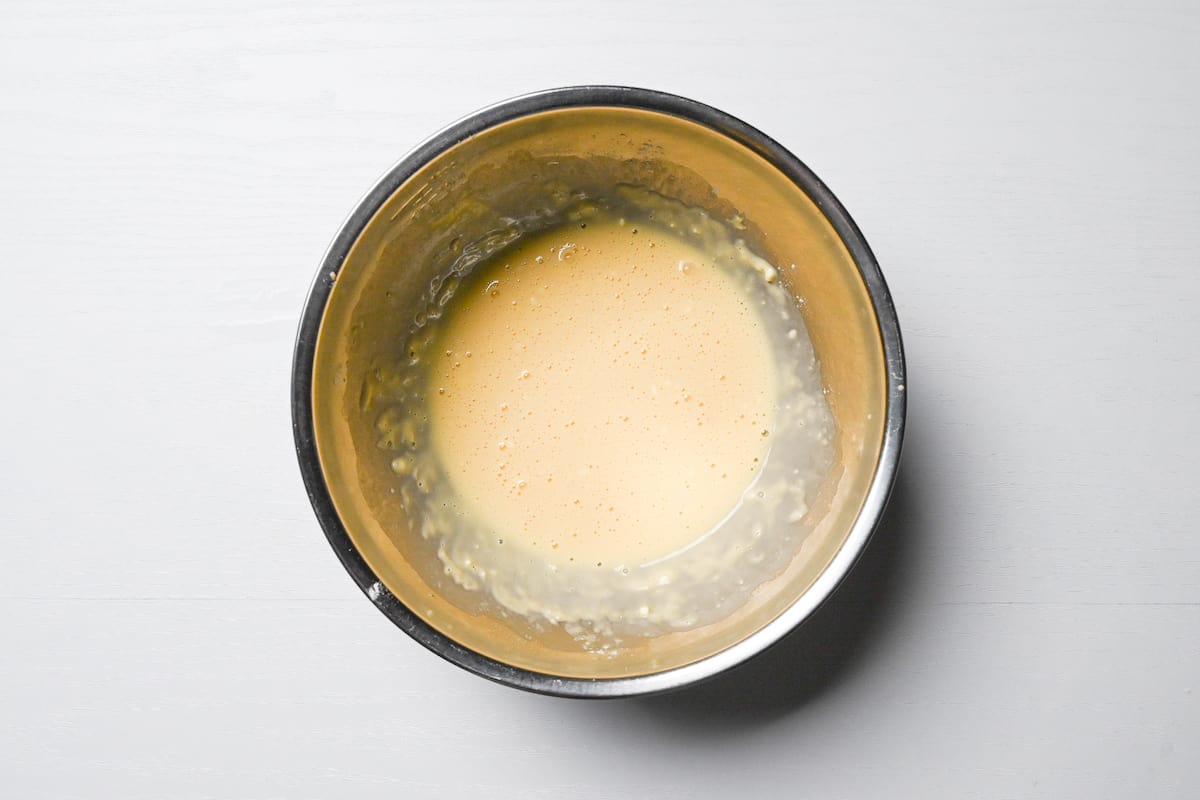
When mixing, use chopsticks or a fork and stir just until combined, leaving small lumps in the batter. Don’t aim for a smooth batter – those little flour pockets create the characteristic texture of authentic tempura!
Overmixing develops gluten, which leads to a heavy, bready coating rather than the delicate crispness we’re after.
Potato starch contains no gluten and creates a distinctly crisp coating. The original Toriten from Beppu’s Toyoken restaurant actually used a blend of wheat flour and potato starch. If you can’t get potato starch, you can use cornstarch instead.
Preheat your oil to exactly 170°C (340°F). If you don’t have a thermometer, test by dropping a small amount of batter into the oil – it should rise to the surface immediately with gentle bubbling, not sinking or browning too quickly.
Use a neutral-flavored oil with a high smoke point, such as vegetable, canola, or rice bran (my personal favorite).
If you’ve already mixed your tempura batter and you’re waiting for your oil to heat up, store it in the fridge to keep it chilled or drop a few ice cubes. Cold tempura batter works best and should be kept chilled while you’re not using it. This includes the time between batches if you’re making a lot!
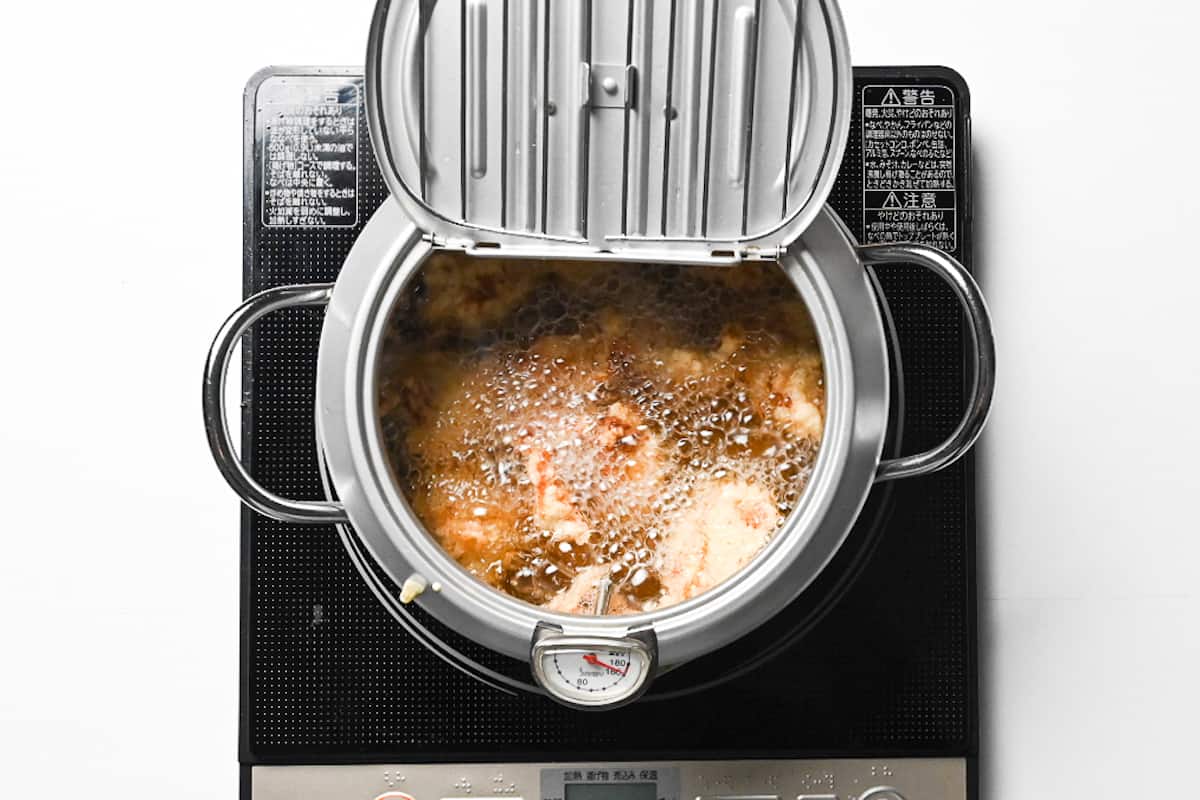
When the oil is at the right temperature, gently drop the chicken pieces into the batter, making sure they’re fully coated. Then, add them to the oil one by one, keeping them away from you so you don’t get splashed.
Avoid overfilling the pot as this will reduce the temperature of the oil and not only will the chicken tempura cook more slowly, but the batter could become saturated and oily.
Fry for 4 minutes in total, turning halfway through. The end result should be fluffy and golden. You’ll know they’re done when the bubbling sound changes from active bubbling to a quieter “crackling” sound and the batter turns a light golden color.
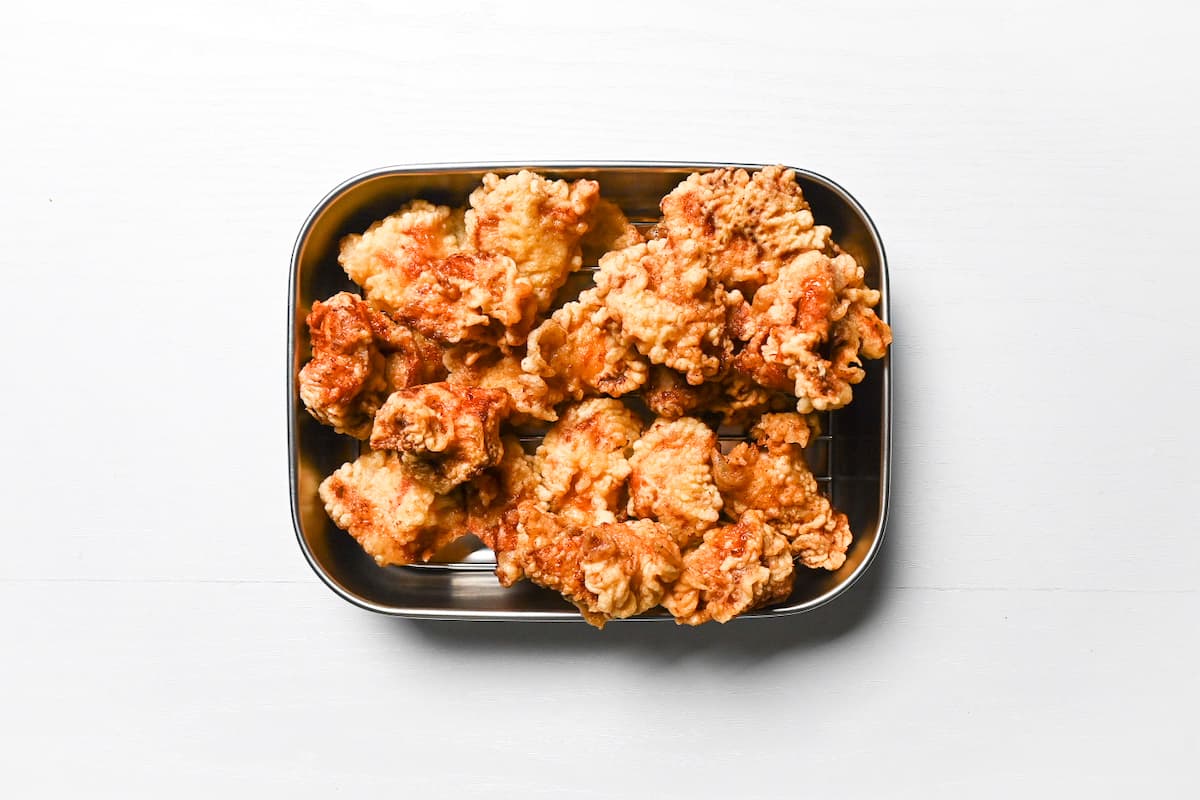
When you’re done cooking, move the Toriten to a wire rack instead of using paper towels. This lets air circulate underneath, so the bottom doesn’t get soggy.
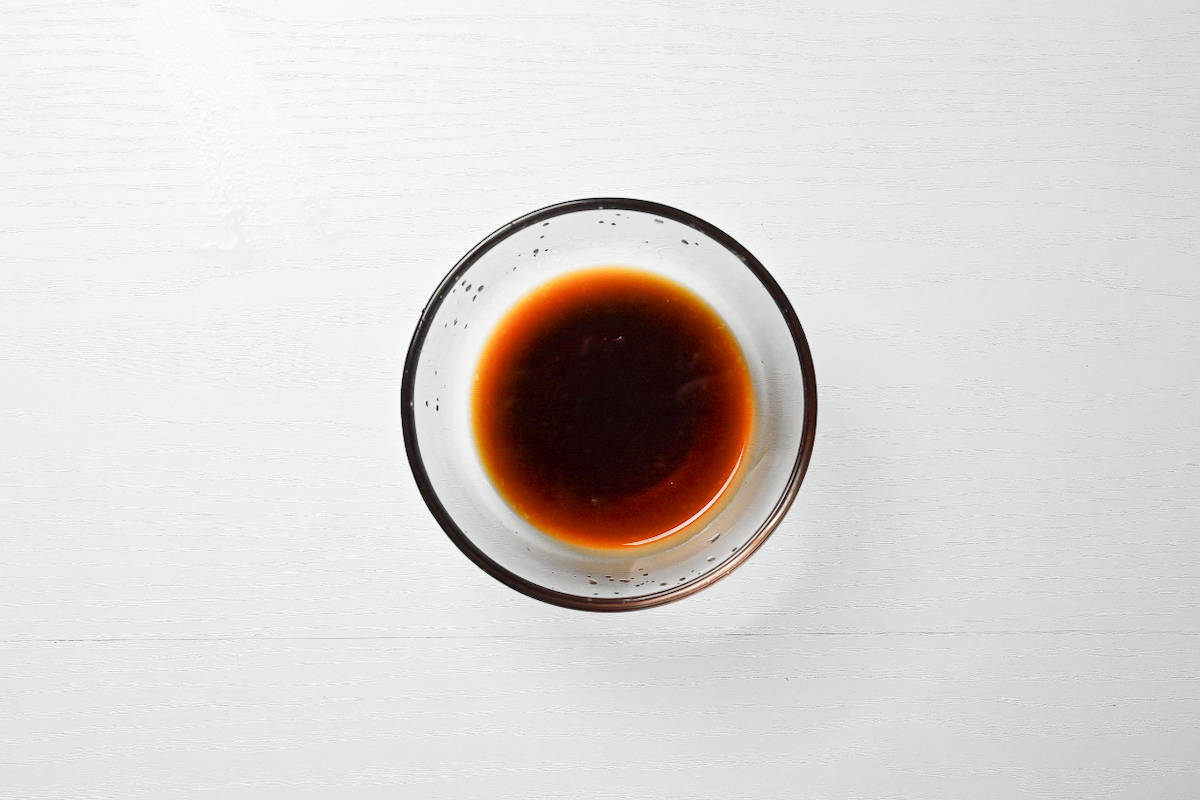
The finishing touch is the tangy dipping sauce that perfectly balances the richness of the fried chicken. Mix kabosu juice (or substitute with yuzu, lime, or lemon if unavailable), soy sauce, and rice vinegar in a small bowl.
If you’re looking for a really authentic Oita-style experience, you can try adding a bit of karashi mustard to the sauce, but it’s totally up to you.
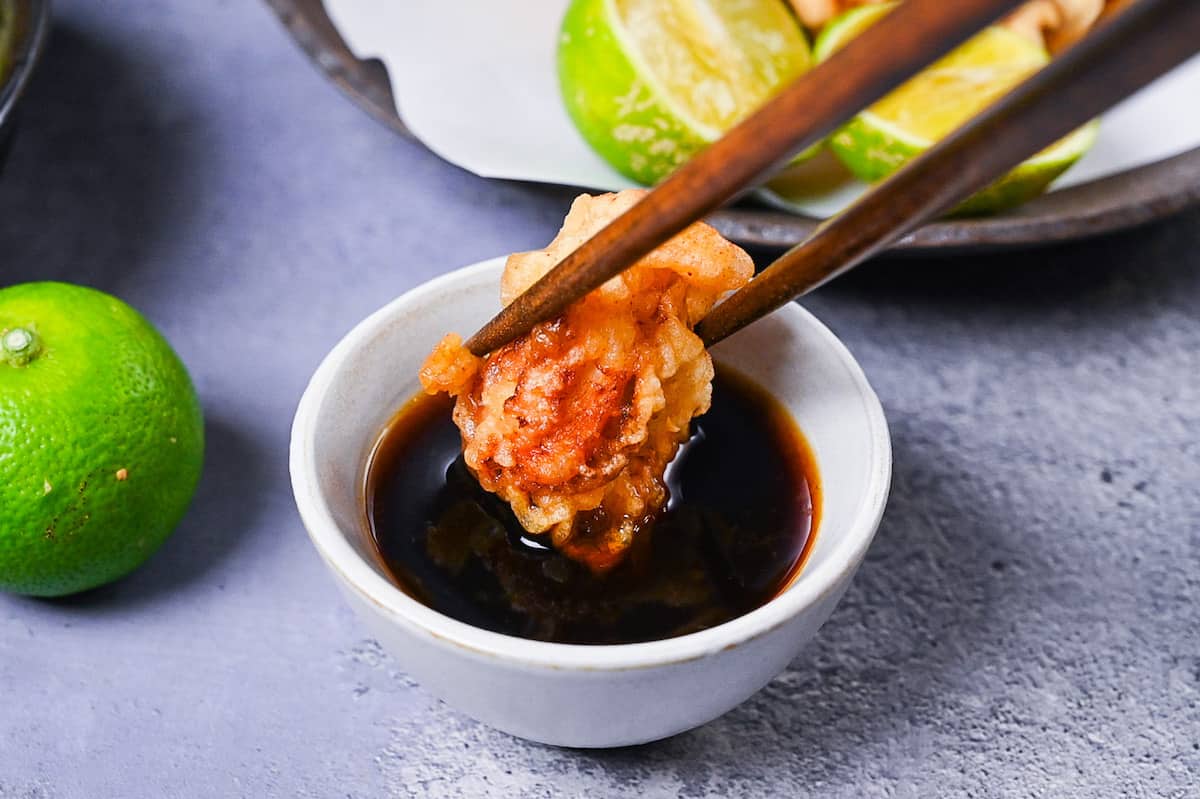
Essential Tips & Tricks
- Marinate for exactly 30 minutes – no longer! The ginger enzymes will over-tenderize the meat if left too long. Over-tenderized meat has a mushy texture.
- Use ice-cold water in your batter and keep the batter chilled at all times to prevent gluten formation.
- Mix the batter minimally and leave small lumps – a perfectly smooth batter will result in heavy, not crispy coating.
- Don’t overcrowd the frying pot – add chicken pieces one by one, leaving plenty of space between them.
- Drain on a wire rack, not paper towels.
- Serve immediately with the dipping sauce for the perfect balance of crispy, savory chicken and tangy sauce.
With these simple tips in mind, you’re set for success every time you make Toriten.
Meal Prep & Storage
Toriten is not well-suited for meal prep. The crispy, light texture that makes this dish special deteriorates quickly once cooked, and the batter becomes soggy when stored. For the best experience, Toriten should be prepared and eaten immediately after cooking.
- Marinade Prep: You can prepare and portion the chicken, and make the marinade to store separately up to 24 hours ahead. Note that marinating longer than the recommended 30 minutes will intensify the flavor and may over-tenderize the meat, so it’s best to add the marinade just before the 30-minute window before cooking.
- Sauce Prep: The dipping sauce can be mixed and refrigerated up to 3 days ahead. Store in a sealed container and whisk briefly before serving.
For storage, if you have leftovers, store them in the refrigerator in an airtight container for up to 2 days. To reheat, avoid the microwave as it will make the coating soggy. Instead, place the Toriten on a wire rack in a preheated oven at 180°C (350°F) for 5-8 minutes until heated through and somewhat crispy again.
Note that reheated Toriten will never match the texture of freshly made.
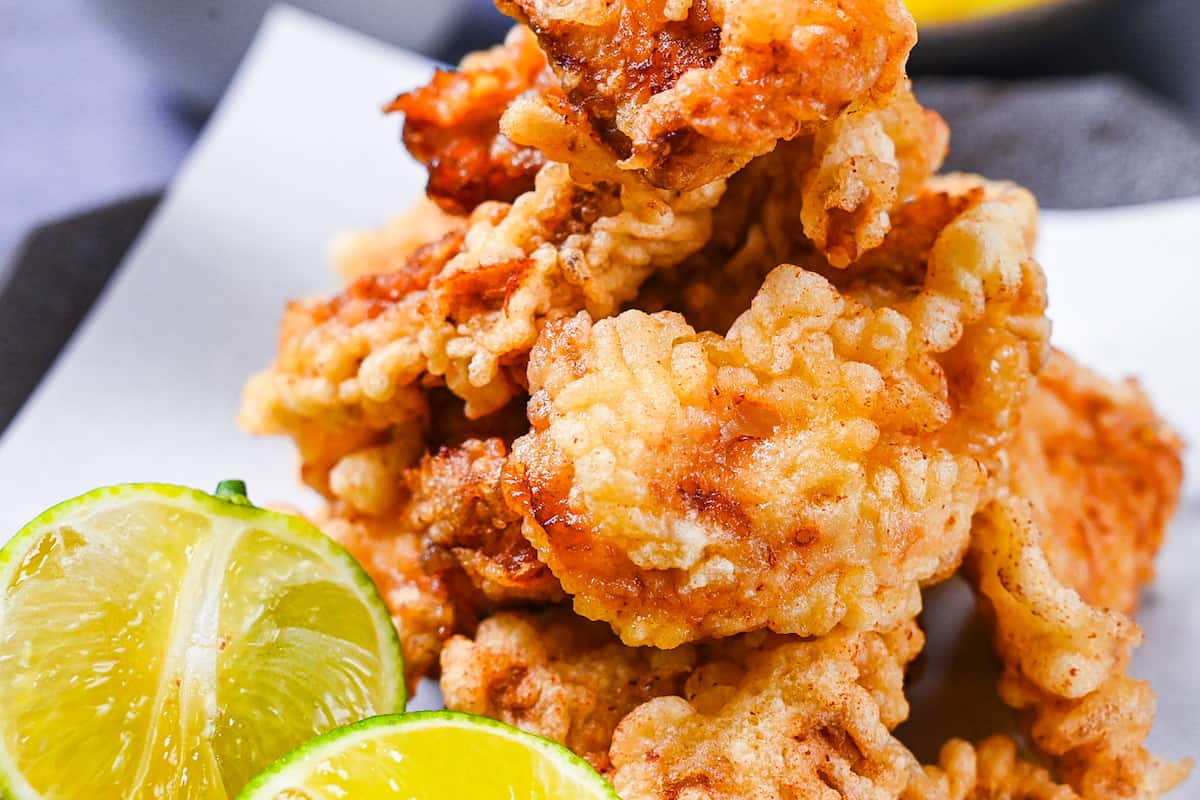
Serving Suggestions
FAQ
Here are answers to frequently asked questions I have received across all platforms, including here, YouTube, Instagram, and Pinterest. If you have any questions, feel free to send them to me anytime! It will be a big help for everyone in this community!
Yes, you can use chicken thigh instead of breast. In fact, in Oita Prefecture (where Toriten originated), people debate whether thigh or breast is better! Thigh meat is naturally juicier and more forgiving if slightly overcooked.
Kabosu is a citrus fruit native to Japan, particularly associated with Oita Prefecture where Toriten originated. It it closely related to yuzu and has a unique tartness similar to lime but with distinctive floral notes. Good substitutes include yuzu juice, lime juice, or a combination of lemon juice with a touch of orange juice to balance the acidity.
While you can make the batter with only wheat flour, the potato starch is important for achieving authentic Toriten texture. It creates a lighter, crispier coating because it contains no gluten. If you don’t have potato starch, cornstarch is the best substitute. The original Toriten from Toyoken restaurant in Beppu specifically uses this flour-starch blend.
If your batter came out heavy or soggy instead of crispy, the most common causes are: the batter wasn’t cold enough, you mixed it too much (developing gluten), the oil wasn’t hot enough, or you overcrowded the cooking pot. Remember that keeping the batter cold throughout the process is essential for preventing gluten formation.
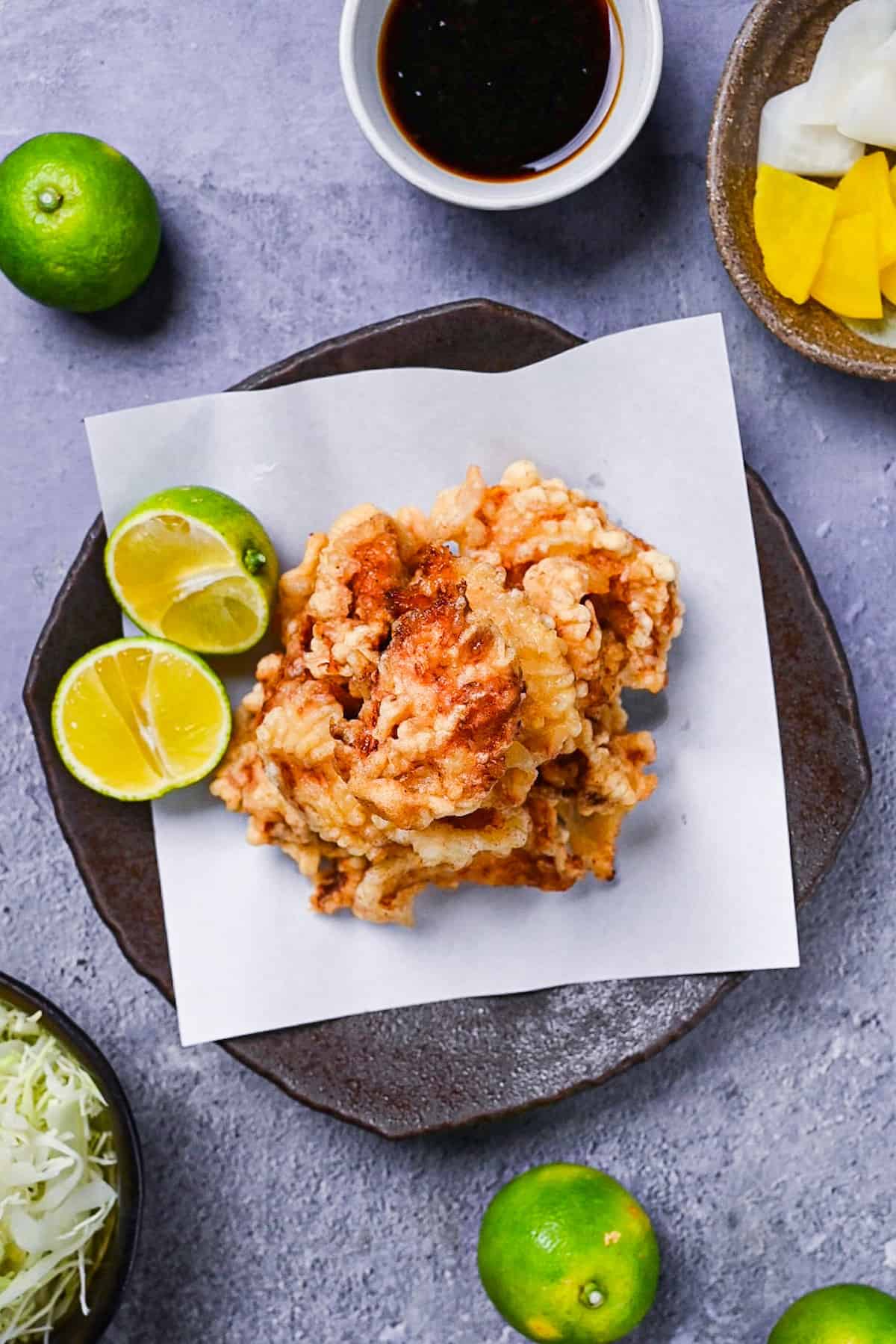
I hope you enjoy this Toriten recipe! If you try it out, I’d really appreciate it if you could spare a moment to let me know what you thought by giving a review and star rating in the comments below. It’s also helpful to share any adjustments you made to the recipe with our other readers. Thank you!
More Japanese Chicken Recipes
- Crispy Japanese Teriyaki Chicken
- Chicken Tatsuta Age (Shallow-fried)
- Yamachan Chicken Wings (Nagoya Style Tebasaki)
- Karami Chicken (Saizeriya Chicken Wings Copycat Recipe)
Want more inspiration? Explore my Chicken Recipe Roundup Post for a carefully selected collection of tasty udon recipe ideas to spark your next meal!
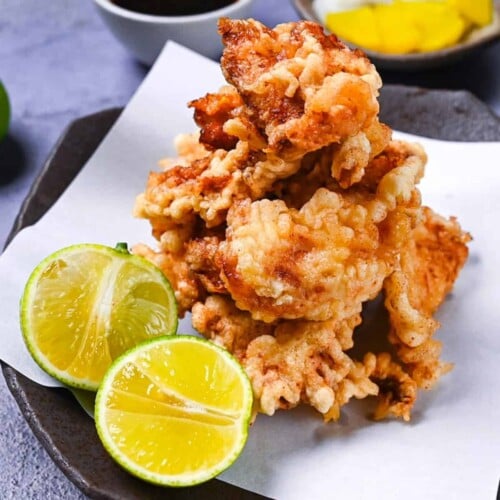
Japanese Chicken Tempura (Oita Style Toriten)
Ingredients
- 400 g chicken breast preferable skin-on, or boneless thigh meat
- cooking oil for deep-frying, vegetable, canola, or rice bran
Marinade
- 2 tsp Japanese soy sauce (koikuchi shoyu)
- 1 tsp grated ginger root fresh, not from tube for best enzyme action
- 1 tsp grated garlic
- 1 tsp sake or dry white wine
- 1 tsp toasted sesame oil
Toriten batter
- 1 egg cold, straight from refrigerator
- 50 ml water ice-cold for crispiest results
- 4 tbsp cake flour or all-purpose flour
- 3 tbsp potato starch (katakuriko) or cornstarch
Toriten dipping sauce
- 1 tbsp kabosu juice or yuzu, lime, or lemon juice
- 1 tbsp Japanese soy sauce (koikuchi shoyu)
- 1 tbsp rice vinegar
- ¼ tsp Japanese mustard (karashi) optional, for authentic Oita style
My recommended brands of ingredients and seasonings can be found in my Japanese pantry guide.
Can’t find certain Japanese ingredients? See my substitution guide here.
Instructions
- Cut 400 g chicken breast into large bitesize pieces.

- Add 2 tsp Japanese soy sauce (koikuchi shoyu), 1 tsp grated ginger root, 1 tsp grated garlic, 1 tsp sake and 1 tsp toasted sesame oil to a mixing bowl, mix well and add the chicken pieces. Mix until the chicken is fully coated, cover with plastic wrap and rest in the refrigerator for 30 minutes. (I also recommend measuring out the water for the batter at this point and chilling for 30 minutes too!)

- Start heating your oil to 170 °C (338 °F). While you wait, gently whisk 1 egg with 50 ml water straight from the fridge, being careful not to let it become too foamy.

- Sift 4 tbsp cake flour and 3 tbsp potato starch (katakuriko) into the bowl and mix gently, it's okay if there are small lumps in the batter.

- Once the oil is preheated, dip the chicken in the batter and deep fry for 4 minutes, turning it halfway through.

- Transfer the cooked toriten to a wire rack to allow the excess oil to drain off.

- Mix the 1 tbsp kabosu juice (or citrus of your choice), 1 tbsp Japanese soy sauce (koikuchi shoyu) and 1 tbsp rice vinegar in a small bowl.

- Dish up and enjoy!

Video
Notes
- Slice chicken against the grain at a 45° angle for more tender results.
- Don’t marinate longer than 30 minutes.
- Keep batter cold at all times by either keeping it in the fridge or adding a few ice cubes to prevent gluten formation.
- Leftover Toriten can be stored in an airtight container for up to 2 days – reheat in oven at 180°C (350°F) for 5-8 minutes (never microwave).
- Serving ideas: Cooked Japanese rice, Authentic miso soup, Spinach ohitashi, Pickled Napa cabbage.
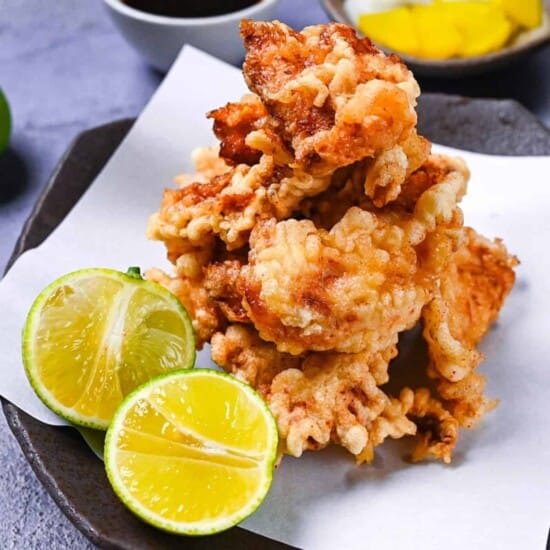




Would mirin be an okay substitute for the sake?
You can, but I think a better substitute would be dry white wine or dry sherry. Thanks for your question!
Great recipe! Worked wonders and enjoyed by the whole family. I did the sauce on Yuzu juice instead but it got abit stingy so Ill be more careful next time
Thanks from Sweden
Hi, thank you for trying this recipe and sharing your experience!
Aloha Yuto!
Can you recommend to me a tempura/deep fry pot like the one you use for this recipe? I’m looking for one that is made well and is not too large so that I can use it for two people and not have to waste so much oil (in larger pots I have)?
Mahalo,
Kiyo
Hi Kiyo,
Thank you for the question!
You can actually buy the exact same model that I use (Yoshikawa Tempura Pot) on Amazon.com! You can also check out the tools and equipment I use and recommend on my storefront page!
I hope this answer helps!
Yuto